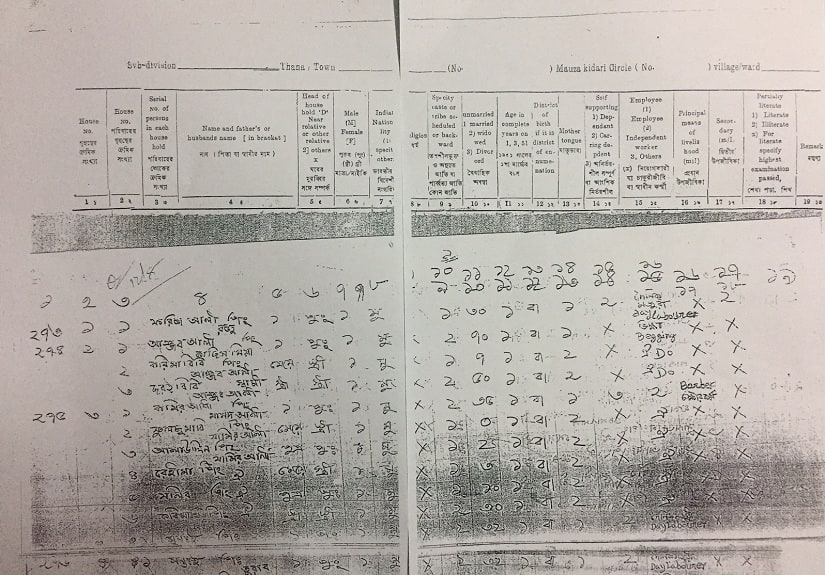New Delhi: On the eve of first census and National Register of Citizens (NRC) in 1951, the message from the then Union home minister C Rajagopalachari to the officers was simple: “We need to prepare a record of basic facts relating to the life and livelihood of all citizens and families in our Republic.” Similar sentiments were echoed in the communication from BR Medhi, then chief minister of Assam, who told 18,850 officers involved in the complex task in the state that these records will help the government formulate policies to overcome the problems of poverty, illiteracy and backwardness. Widespread communal disturbances in Cachar, Goalpara, Kamrup, Nowgong and Darrang — followed by a heavy influx of refugees in February-March 1950 — was clearly weighing heavily on the minds of the two leaders, and their aim must have been to stop the growing burden on the state’s resources. [caption id=“attachment_4863911” align=“alignleft” width=“380”]  People wait in a queue to check their names on the final draft of the NRC. PTI[/caption] As per the Jawaharlal Nehru government’s estimate in 1951, around 5 Lakh refugees had entered Assam, but the number actually recorded in the first NRC, which is part of legacy data now, was only 274,000. A file in the home ministry, which has been kept under lock and key, observed that the discrepancy in numbers was primarily because the refugees were constantly on the move from one place to another. The aim and scope of NRC in 2018 is the same as it was in 1951: To purge illegal immigration. There could be a debate on legacy data and its accuracy, and rightly so, but politics overshadowing the entire exercise may not further the State’s interest, and the blame game may end up denying the obvious truth. Just like the Nehru government, the NDA too is trying to allay the fears, assuring the 40 lakh persons not in the NRC draft list that they will get an opportunity to claim citizenship, and that no coercive action will be taken against them. But the task was much easier for Nehru’s government; 67 years have turned the DNA of politics around, and despite statements made by the state and central governments regarding the possibility of amendments to legacy data, political parties still continue to add fuel to the fire. Then there are questions like what will happen to the people figuring in the final list. Will those identified as Bangladeshi be sent back? The answer is in the government’s written reply to the Lok Sabha on Tuesday, whereby it clearly stated that deportation of Bangladeshi nationals is a contentious process, and in 2016-17, a total of 39 nationals were deported from detention camps in Assam. The home ministry also said that Dhaka verified 53 Bangladeshi nationals from Assam recently and issued travel documents for them. But the numbers in the present case will be huge. A home ministry official said various options are available with the government. “During the Atal Bihari Vajpayee regime, when a ‘Multi-Purpose Identity Card’ was conceptualised to identify the citizens, a proposal was discussed not to deport the illegal immigrants living in the country for the last two generations. The idea was that they would be identified and provided with work permits, which would ensure they don’t enjoy the benefits of full citizenship until it’s legally granted through due process. A similar approach could be adopted in the present circumstances, but the government needs to have a final list first. The process is not over yet,” the officer said. [caption id=“attachment_4863921” align=“alignnone” width=“825”]  The NRC exercise was conducted by the Jawaharlal Nehru government in 1951[/caption] There is also the criticism that genuine citizens were left out of the draft NRC. The home ministry officer said 1951 legacy data is bound to have some issues as it was purely a statistical exercise. He also said that in early 2014, a central team comprising officials from the Registrar General of India (RGI) had visited Assam, randomly picked up a district to check whether the 1951 NRC register was tampered or not. “This was done for Kamrup district and only few records were found to be tampered with, minuscule in comparison of records. A few names were found to have been added in some records, but the ink used to insert this betrayed the altering of data that took place. Overall, however, the records were found to be intact,” the officer said, further adding that nowhere was the schedule for NRC and census based on religion, while these have been primarily looking at identifying illegal immigrants. In 1951, the NRC cost the Centre and the state of Assam close to Rs 36,974, while Rs 1,200 crore has already been spent on the ongoing exercise, which was slammed by the Opposition for being badly implemented. Of course, any exercise at such a large scale would leave much to be desired and changes have to be done to accommodate genuine citizens as well, but the government must not lose focus of illegal immigration. Even in 1951, the officers involved in the NRC weren’t fully satisfied, and admitted to lapses in records. A deputy superintendent of Jorhat said in May 1951: “I fully realise the difficulties, but the handicaps in one form or another are bound to recur in an ad hoc arrangement on such a large scale, and the future superintendent and his deputies will have to remember with patience that a ‘bad workman quarrels with his tools’.”
The aim and scope of NRC in 2018 is the same as it was in 1951: To purge illegal immigration. There could be a debate on legacy data and its accuracy, but politics overshadowing the entire exercise may not further the State’s interest
Advertisement
End of Article


)

)
)
)
)
)
)
)
)



